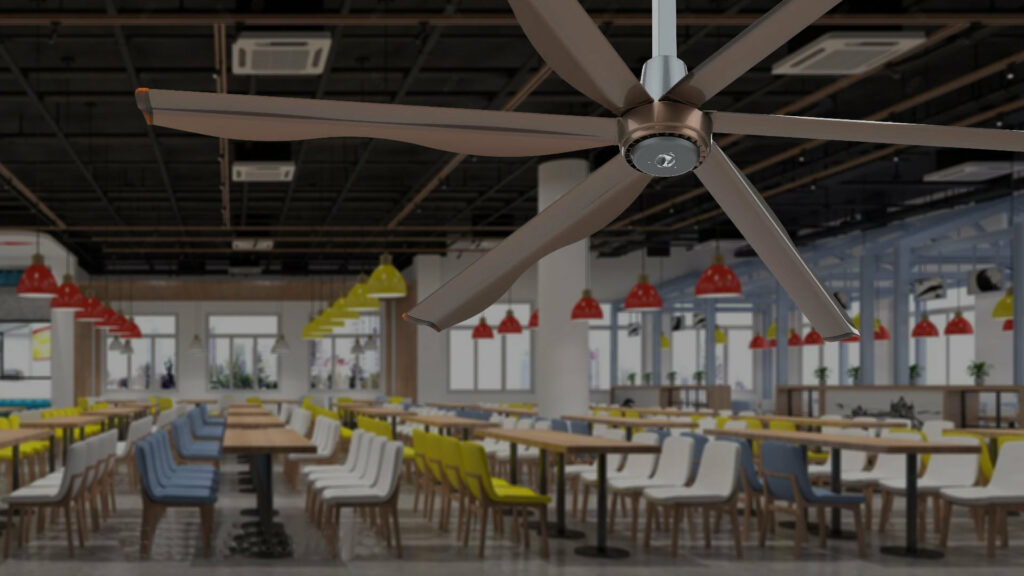Architects and designers are always on the lookout for the statement piece that will pull their entire concept together—whether it’s a piece of furniture, a work of art, or even a practical appliance.
Ceiling fans and other air circulation devices are often an afterthought for the designers of industrial and commercial spaces. And yet a good designer understands the ways in which a fan can not only complement an aesthetic theme, but also serve critical functions that impact the health and well-being of the employees, customers, and others who occupy that space.
Diamond Fan has long dominated the residential air circulation market, specializing in HVLS (high-volume, low-speed) fans.
The increased awareness of ways indoor air quality can have a dramatic impact on the health of employees and overall building health was a catalyst for Diamond Fan to dive into the industrial market.
We discuss the ways HVLS fans act as a whole-room design solution while also improving air quality and well-being.
What are the main benefits of HVLS fans?

Two of the most significant environmental improvements provided by HVLS fans are the cooling effect provided in warm weather months and destratification—the process of drawing down of warm, heated air that collects at the ceiling and bringing it down to where people are in cold weather months. The continuous mixing of air promotes a more uniform temperature throughout the facility, from floor to ceiling, while also lowering the concentration of harmful pathogens within the air.
This promotes a comfortable and healthier work environment by reducing absenteeism, employee complaints, and overall employee turnover. Air circulation from an HVLS fan can also help keep condensation from settling on the floor and on products, which can reduce moisture-related issues within facilities.
There is also the substantial benefit of reduced energy consumption. HVLS fans move larger volumes of air while using less energy than high-speed fans or traditional HVAC systems, while also producing a less disruptive wind speed.
Now, not all HVLS fans are created equal. Hunter Industrial fans, for being as big as they are, are a lot lighter than you’d expect—about 20% lighter than a lot of other competitors. This means far less labor and time for installation, further reducing overhead costs for our customers.
What should architects consider before setting out to design a space?
I think the most critical question for architects and interior designers is: What will the occupants of the building—whether they are customers or employees—need in order to feel the most comfortable in this space? Those needs will be significantly different across residential, commercial, and industrial spaces. For example, if it’s a logistics warehouse with really high ceilings, they’ll need to move a lot of air, which tells us our HVLS fans are what they need as opposed to smaller commercial solutions.
For design professionals, it’s important to understand the threshold of comfort that is desired based on the atmosphere that the end user is aiming for. This is really about finding the ideal marriage between aesthetics and performance.
For commercial spaces like restaurants where the overall ambiance is top of mind, you’ll probably be considering the aesthetics of the fan ahead of its air circulation benefits. For smaller areas like this our HVLS fans, will be the ideal solution. On the other hand, industrial users want to prioritize function over form, as they need to ensure that the temperature and air quality in the space is conducive to employee health and productivity.
And then it’s also important to understand the power voltage that’s available, the size of the space, and to identify any potential interferences with the fans—are there beams or racks in the space that we need to worry about the fan having clearance?
What design opportunities do HVLS fans offer?
If you’re designing a tropical restaurant along the shore, we have access to fans that would seamlessly fit with this design. If you’re remodeling a vintage warehouse into a loft office space, we have countless options that can fit a rustic, industrial aesthetic. We even offer chandelier fans.
By industry standards, Diamond Industrial HVLS fans are some of the most aesthetically pleasing and user-friendly fans on the market. For instance, Diamond Industrial designed a capacitive touchscreen control that simplified the customer experience when compared to clunky wall controls of the past. They feature a sleek design that would be appropriate in a number of commercial applications where the performance of the fan is just as critical as appearance. Hunter Industrial was also the first company to develop a direct drive motor, which is smaller and quieter than the gearbox motors that are pretty standard in the HVLS market.
Although fans are often an afterthought, they really do have the ability to pull an entire space together through thoughtful and intentional design.

